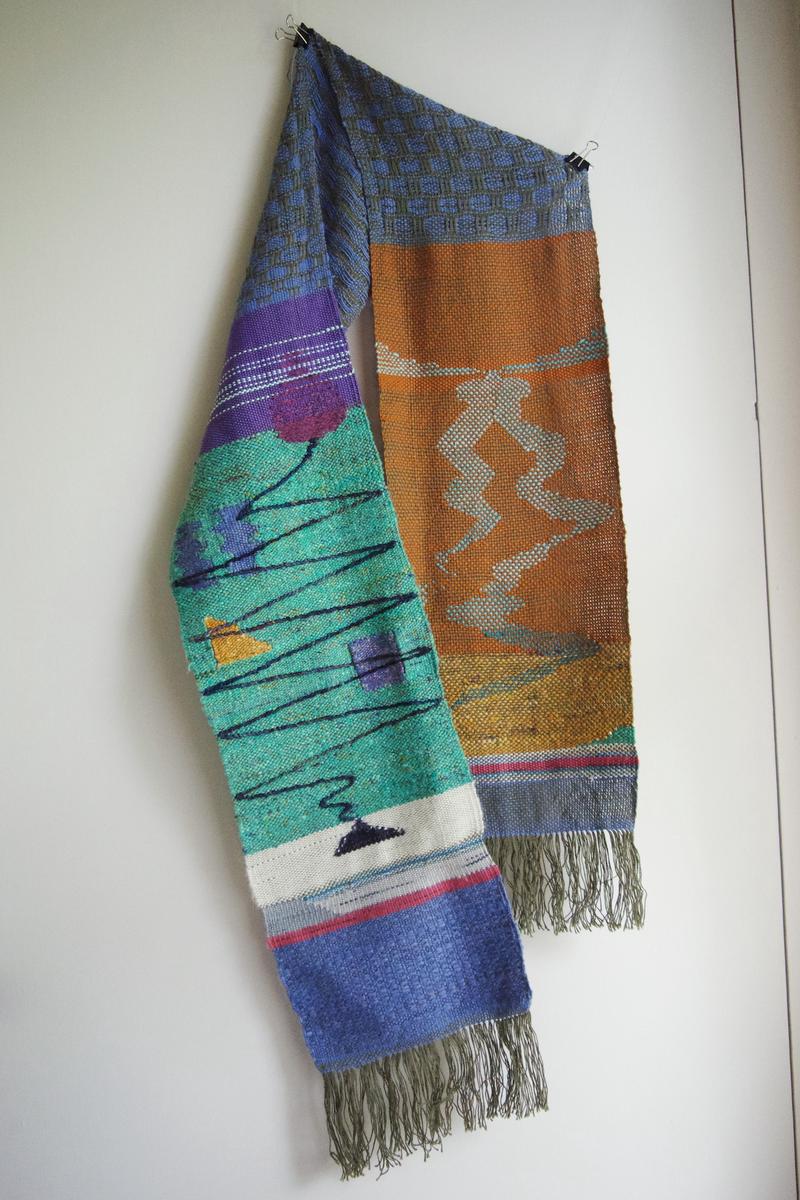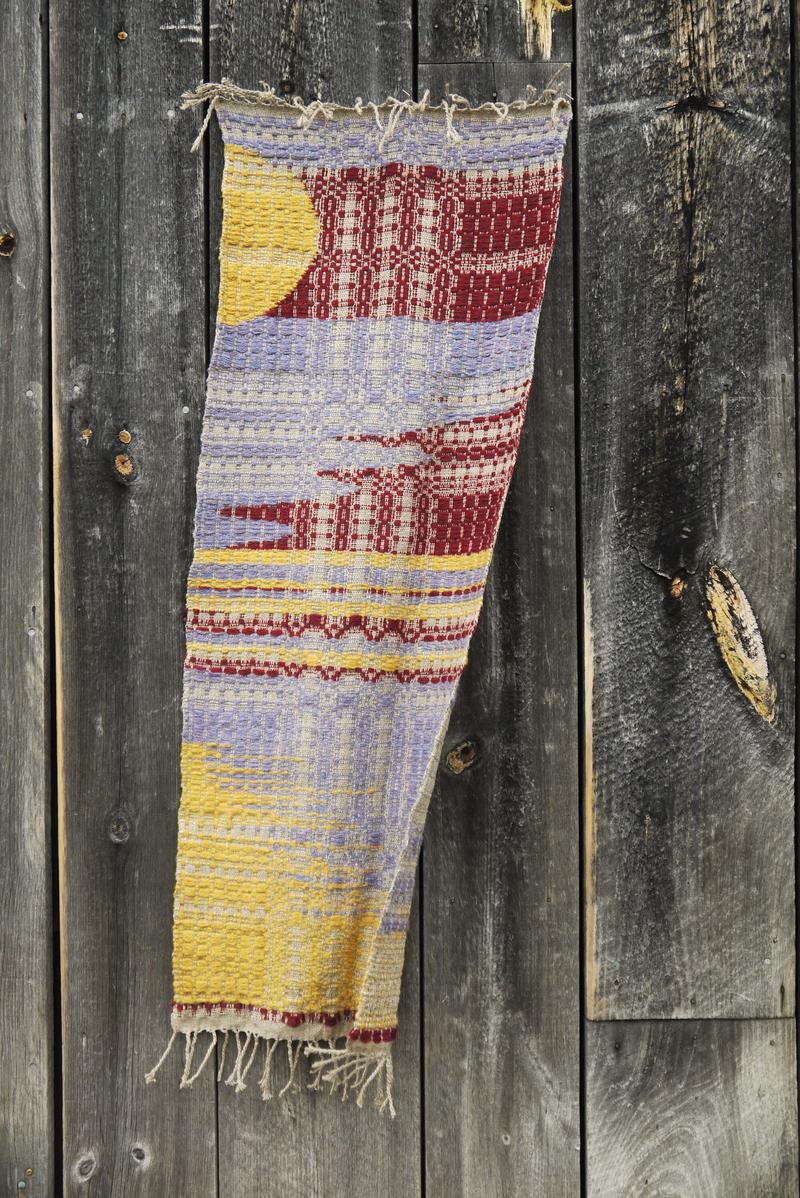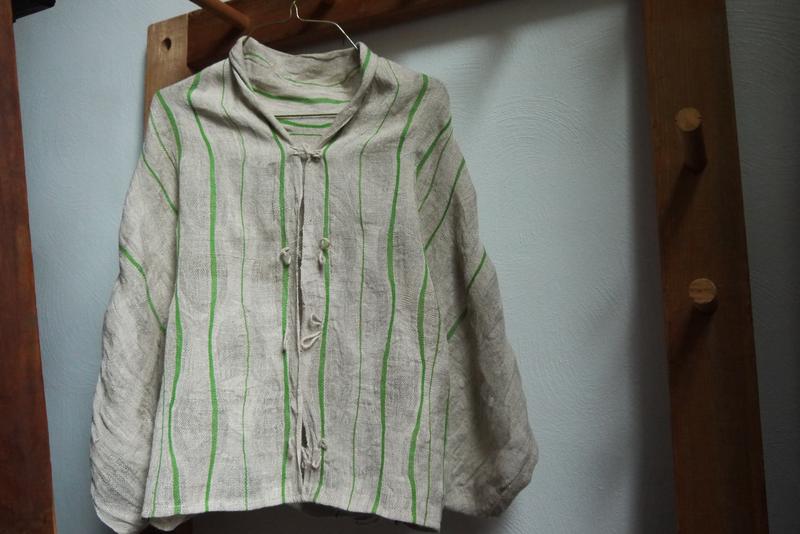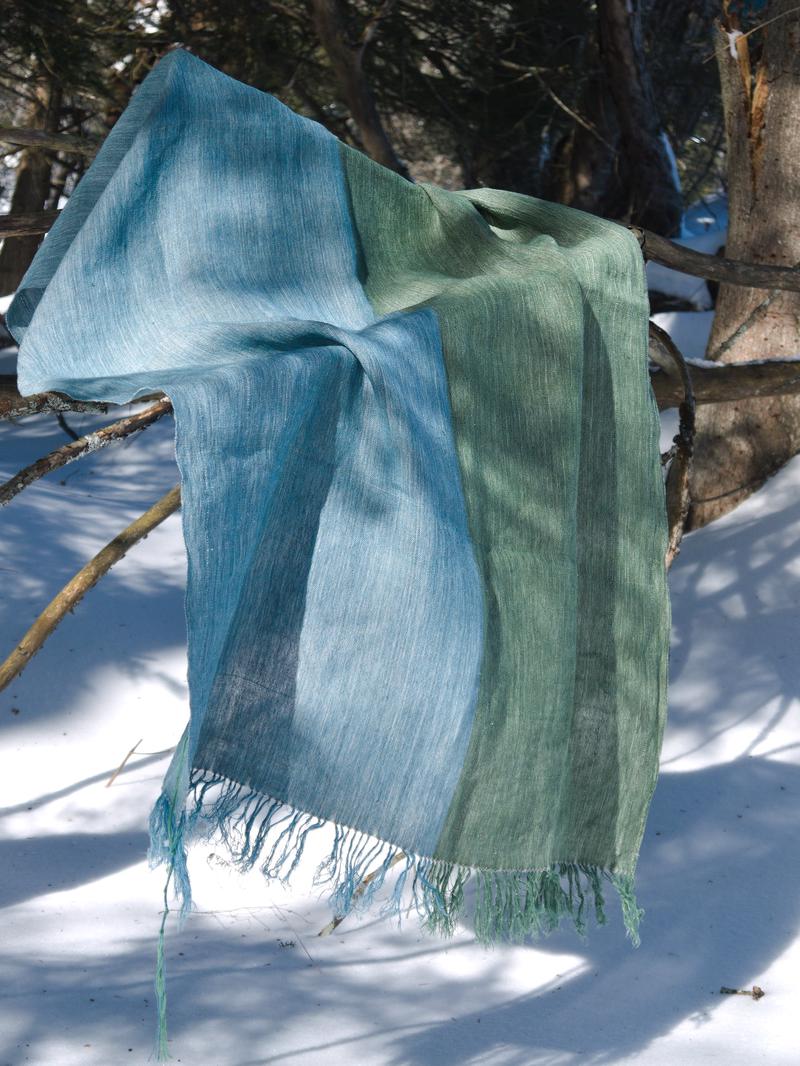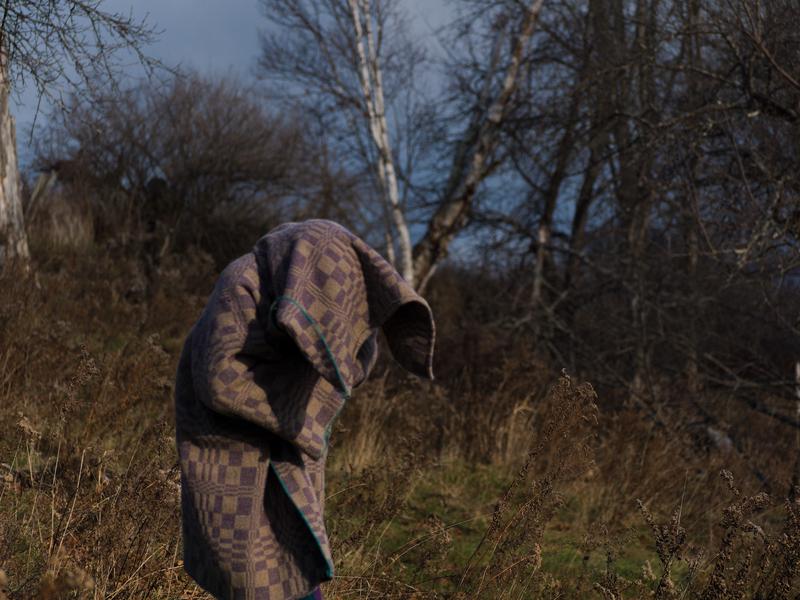Extending Arachnid Consciousness
This is the lightly expanded text of a presentation given at the Diverse Intelligences Summer Institute, an interdisciplinary cognitive science program, in July 2021. I am grateful to Romi, Les, and Mariel for asking me questions about weaving and offering knowledge about extended cognition, and to eva for her feedback on this transcript.
Spiders and humans both “weave,” claiming conceptual overlap between two otherwise quite different activities. Each uses unique materials, structures, and bodily processes, so what do they have in common? I'd like to probe a parallel between the two in one specific area: how it feels to sense on and through an external structure, i.e. the web or the loom. This connection abstractly hints that some cognitive operations are fibrous, and that they might be helping reproduce species- and culture-specific epistemes.
Loomlike agency
Just to get a sense of how this type of weaving works, here’s a video of me and a barn loom I’ve been working on/with recently. (Important disclaimer: there are thousands of different weaving traditions around the world that share some elements pairwise, but of course my practice isn't representative of that wide world.) This loom's 300 years old, it’s physically and sensorially immersive, it’s a VR system that surrounds my body. The key structural components of the weaving here are two perpendicular sets of threads: the warp is stretching away from me towards the back of the loom, and that’s what’s set up beforehand. The set of threads I’m passing back and forth across it on the wooden shuttle is called the weft. At some point I take my socks off because I really need to feel what’s going on with the soles of my feet. I’m using my feet to control the structure, pressing treadles that raise and lower the warp threads to form a matrix of interlacements.
In that video, I am dictating the structure, but its actual implementation—the selection and moving of individual warp ends—is handled by the loom. That's why I can throw the shuttle quickly from edge to edge and not do anything else with my hands. This type of weaving would be called loom-controlled. Other techniques rely much more on manually placing and manipulating individual threads or regions with a higher degree of granularity, which would be called finger-controlled weaving. Let's look at some examples.
This stole (Fig. 1) is an early piece of mine, with geometric shapes on the left and a person whose legs are turning into rivers on the right. The loom I used is called a rigid heddle loom, which can mostly only produce plain weave. So to make these more complicated figures, I had to use finger-controlled techniques from tapestry: discontinuous and supplementary weft, which enable freehand forms with a little extra work from the weaver. With each pick or row of weaving I chose where on the cloth to enter and exit the interior of the shape I was on, stacking them together in thin slices over the course of each section. These aren't always planned, so I don't have to do any math— not in my head, at least. Instead, the translation of curve to grid happens in real-time and in the body, and I can mutate it mid-stream based on the forms I see emerging.
On the other hand, the pattern on this rug (Fig. 2) is the opposite of freehand: the loom controlled the expression of the geometry, with me asking it for one of only four block permutations each pick. I didn't have my hands in the web adjusting boundaries like in the stole; I threw a shuttle all the way through, and the loom raised and lowered the warp ends needed to produce the motifs. The sequence I treadled the blocks in could also have been flexible, as I've done on other rep rugs. For this one though, I had decided in advance a rule system for the five waves of figures: they would alternate height between 5 and 3 inches, and be symmetric in the warp direction. So my choices were constrained by two external factors: the threading of the loom and my adherence to those rules.
Then this table runner (Fig. 3) is a nice illustration of co-occurring influences, because it has a foot in each world. The placement of the lattice-like areas of color and areas of grey were controlled by the loom, but within those areas the color changes themselves and the borders between colors were done by hand, with a clasped weft technique. That is, the loom remembered the shape of the container, which freed me up to gradually shape the zigzags and semicircle within it.
Even with a heavily loom-controlled structure, small differences in weaver choices can result in a wide range of variation. I'm interested here in how these two agents enable each other, and how their interaction on the web can result in emergent complexity in multiple dimensions.
Spidery sensations
As much as I like to talk about spiders, it's hard to know what they feel like. I've found Eva Hayward’s piece “Spiderwomen” a helpful jumping-off point in taking a human read on the phenomenology of spidery sensation. She theorizes a sense of not being a static or uniform subject in the world, but rather being spread out and feeling things from a lot of different directions in a lot of different places on an expansive but connected sensory system:
Silken spiderlines reference the skeletalization of surface; the web is an extension of the surface affects of the spider—it feels with its web. This is not a shallow surface, but a dynamic threshold of sensuality. Likewise, the body is stretched topographically to affectively and perceptually (sensually) react through a spatial and temporal generativity. Bodies are not ruptured or burst open such that they are boundless. Instead, bodies, like cities and web-builders, are inter- and intra-threadings of many sensuous vectors that relay like the spider in its web. Eva Hayward, “Spiderwomen,” in Trap Door: Trans Cultural Production and the Politics of Visibilty, edited by Tourmaline, Eric A. Stanley, and Johanna Burton, 2017
In cognitive science, this approach would align with the school of extended cognition, as applied to spiders by Japyassú and Laland. They try to answer why there can be such consistency in cognitive processing ability for spiders across a 400,000x size difference. Their theory is that spiders offload the processing of certain core tasks to their (and others’) webs, which don’t have the same size constraints as their central nervous systems. One heuristic for deciding where extended cognition holds is the mutual mutability criterion: if you change the web it changes how the spider acts, and conversely if you change the spider’s subjective state it will change the physical structure of the web. If we have evidence for both of these directions of influence, they would consider the spider and the web to form a single, integrated cognitive system.
The claim of the extended cognition approach would be, in the case of web building, that the use of the structural connections and organisation of the web as integral components of the cognitive system itself would reduce the necessity for cognitive processing within the CNS. Hilton F. Japyassú and Kevin N. Laland, “Extended Spider Cognition,” Animal Cognition 20, 2017
I’d encourage you to read the paper; they give two really interesting examples where mutual mutability holds in the domains of sensing and memory. One issue I noticed as I was reading was how unidirectionally spider-centric their framing is. It emphasizes what the web is doing for the spider, with less suggestion of what the spider might be doing for the web. I’d like to ask, when bridging these lessons to the parallel context of weaving, what does the loom “want” from the weaver and from the integrated relationship between the two of us? How does it manipulate me to materialize its desire? How do those parts of the system, not just the sentient part, have their agency and intelligence?
An invisible operating system
Spiders’ externalized cognition allows them to do things they “shouldn’t” be able to do based on their brain size. Similarly, I would argue that textiles allow humans to do things we shouldn’t be able to do— processing consciously or unconsciously very complex systems that we can’t fully hold in our minds in their multilevel entirety. Clothes specifically are an operating system for us to externalize social roles, community relation, cultural values, identity, aesthetics, power, and spiritual or ritual processes. Anecdotally, clothing satisfies the mutual mutability criterion: the way you feel and the values you hold alter how you dress, and the way you dress changes how others perceive you and cast you into the social world. These are processing-intensive operations, but textiles are so omnipresent that we take them for granted. Imagine how different it would be to make those same perceptions without them, or what perceptions would replace them in the organization of society.
A throughline of my own weaving is experimenting with this mutability relationship to better understand and shape it. This shirt (Fig. 4), for example, is made with a strange technique called ondulé, which distorts the grid to make the lines wavy, and give these areas of thinner and thicker cloth. Symbolically, ondulé breaks the grid, wriggles out of weaving's ubiquitous orthogonality and straightness.
This takes me in the direction of spiritual textiles, thinking about ritual as a component of extended cognition. I’ve woven two tallitot with this embedded function in mind, commissioned by my friends Liv ז״ל (Fig. 5) and James. Ritual objects such as these aid in processes (broader than computation) of affect, memory, and community. They're flexible-spatial gateways into a headspace of contemplation, meditation, and closeness with the divine or whatever it is you do your business with.
Lastly, I want to think of garments as architectural, or as worlds to inhabit, like the specific ecological niches that spiders build and that have facilitated their evolution. In Japyassú and Laland's words: “since they build their own externalised memory traces, these built ‘environmental’ cues are extremely reliable, allowing the cognitive system to evolve in the direction of extending itself to encompass the previously external, niche-constructed environment (the web itself).” Handwoven webs are traces too, of memory as well as force, affect, and energy. This coat (Fig. 6) is really big, like a blanket, and totally engulfs its wearer. It creates an enclosed volume, internally with its own architectural affordances for observing, feeling, and moving, and externally as a respite from imposed modes of bodily signification and as a shelter from which to embark on disidentificatory projects:
Disidentification is about recycling and rethinking encoded meaning. The process of disidentification scrambles and reconstructs the encoded message of a cultural text in a fashion that both exposes the encoded message’s universalizing and exclusionary machinations and recircuits its workings to account for, include, and empower minority identities and identifications. José Esteban Muñoz, Disidentifications, 1999
Interlacement and interception
To end with a direction for continuing speculation, I'm circling back to the barn loom extended cognition apparatus. I’ve been coalescing an overall concept of arachnid consciousness to refer to the weaving flow state and the phenomenal experience of meaningmaking in the weaving process. The meaning of the process, which is then embedded in the cloth, feels rich and distinctive, yet at the same time cognitively inaccessible or obscured. It articulates as much as a text or song or painting, but the way it carries that message is much harder for me to focus on. The same way that you might have a smell in your mind but no way of describing it. I'm thinking with a logic that escapes the familiar modes I have of examining my own thoughts, e.g., language, numeracy, visuality. Except, that is, for when I join sensorily with the loom— we “hook into” that black box and use its own sensory organs inside itself. That works, and I've learned how to operate that system like it's part of my own body (or vice versa). But it's a sealed and delicately embodied system. When I try to extract meaning from there into my own head or a communicative medium, it dissolves. The only stable substrate is the resulting trace of the textile. Also, I feel like I've been doing an increasing proportion of my everyday thinking in this fiber system, making my thoughts a little more tangled, relational, gestalty, and inscrutable. I'm spinning cobwebs in my mind (which, I was surprised to learn, are descended from orb webs, not the other way around).
Is this opacity somehow an inherent quality of however cognition works, or does it have to do with having practiced some metacognitive repertoires my whole life and not others that would apply to fiber? Either way, we might imagine using arachnid consciousness to complement and target recesses of our subjectivity that elude other modes of description. Alongside language, the mental and social operations of weaving and clothing might play a role in shaping what Sylvia Wynter calls each culture's verbally defined and physiologically implemented sociogenic principle.
Seeing that because all modes of human conscious experience, and thereby, of consciousness, can now be seen to be, in all cases, the expression of the culturally constructed mode of subjective experience specific to the functioning of each culture's sociogenic sense of self, the same recognition can now be analogically extrapolated to the species-specific sense of self expressing the genomic principle defining of all forms of organic life. Sylvia Wynter, “Towards the Sociogenic Principle: Fanon, Identity, the Puzzle of Conscious Experience, and What It Is Like to Be ‘Black,’” in National Identities and Socio-Political Changes in Latin America, edited by Antonio Gomez-Moriana and Mercedes Durán-Cogan, 2001
If such an extrapolation stands, that weaving has been among the engines firing under the hood of culture-specific but naturalized modes of being, then weavers (along with all users of language) have a particular, fibrous role to play in the interruption of the replication of a dominant episteme that naturalizes premature death and structural cruelty. These changes are fundamental, and require something of a scientific awareness of the constant maintenance activity of terms of being through minute but voluntary acts of communication. Perhaps looms, together with a panoply of other co-agentive tools, can help “us” access enough senses for perceiving that maintenance in enough of its dimensions, piecemeal, to learn how to wean off of its symbolic life.
P.S. Coincidentally or not, Wynter opens her essay on sociogeny with an epigraph from David Chalmers, who was one of the two to introduce the extended cognition concept under that name.
